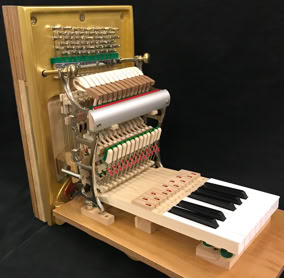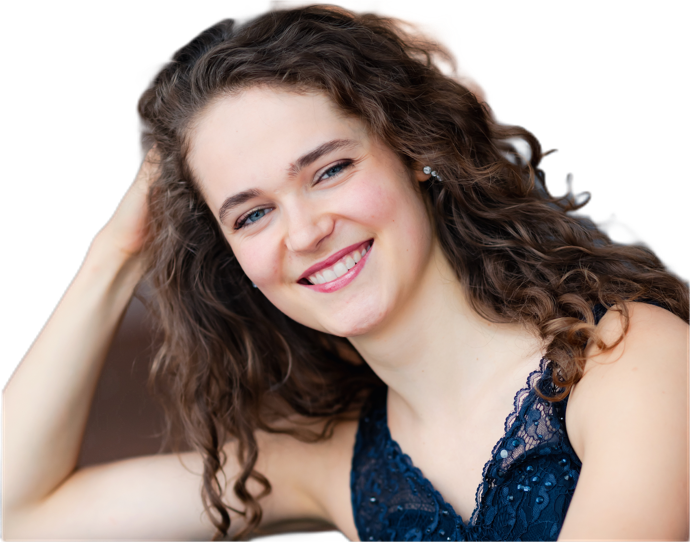Interviews-PianoVrienden

“Mijn grootste hoop is dat ik door het uitdragen van mijn vurige liefde voor muziek deze kostbare, goddelijke vonk kan doorgeven en laten opgloeien in anderen.”
Voorwoord PianoVrienden
Namens PianoVrienden presenteren wij met trots dit interview met Frank. In openhartige antwoorden neemt hij ons mee van zijn eerste, onwaarschijnlijke pianowens tot het podium van grote zalen en de intensiteit van lesgeven. We krijgen een zeldzaam kijkje achter de schermen: twijfels, discipline, inspiratie en idealen. Een leerzaam portret van een musicus die muziek ademt én doorgeeft.
Frank van de Laar. Van eerste noot tot levenslange toewijding




“Eigenlijk ben ik in het pianotechniekerswereldje grootgebracht. Je zou kunnen zeggen dat het virus is doorgegeven, van vader op zoon.”

Voorwoord PianoVrienden
Met dit interview duiken we in de wereld van pianotechniek samen met Sven Taffijn, een vakman pur sang. Wat begint als een familieverhaal, groeit uit tot een internationaal gerespecteerde expertise in restauratie, onderdelen en opleiding. Sven vertelt openhartig over traditie, innovatie en duurzaamheid, en over hoe techniek, ambacht en respect voor het instrument elkaar versterken. Een gesprek voor wie piano’s niet alleen hoort, maar ook wil begrijpen.

"Ik wil muziek blijven delen die uit mijn hart komt — niet alleen om mijn eigen leven te verrijken, maar ook dat van anderen."
Voorwoord namens PianoVrienden
Bij PianoVrienden geloven we in de kracht van muziek als bron van verbinding, inspiratie en groei. In dit interview maak je kennis met een gepassioneerde pianiste die haar eigen weg volgt — met toewijding, nieuwsgierigheid en liefde voor het vak. Haar verhaal laat zien hoe muziek zich verweeft met het leven zelf: binnen en buiten de studie, op het podium en in het lesgeven. We hopen dat deze inkijk in haar reis je raakt, inspireert en herinnert aan waarom muziek ertoe doet.
Het interview met Margaretha Clement

“Deze originele aanpak ben ik overigens nooit bij iemand anders tegengekomen.”
Willem brons
Met trots en dank presenteren wij dit waardevolle interview met een musicus en pedagoog van uitzonderlijke klasse. Zijn liefde voor de muziek, zijn scherpe inzichten en zijn bescheidenheid vormen een inspirerend kompas voor musici van alle leeftijden. Zijn woorden getuigen van een leven gewijd aan verdieping, verbinding en muzikaal vakmanschap. Wij hopen dat deze publicatie niet alleen terugblikt, maar ook stimuleert tot reflectie, vernieuwing en vooral: een eerlijke, toegewijde omgang met muziek en het menselijk hart.


"Tussen hemel en toetsen: het muzikale leven van Ralph van Raat"
Met grote dank en bewondering spreken wij onze waardering uit aan Ralph van Raat, die — ondanks een drukke agenda en vanuit het verre Los Angeles — de tijd nam voor een uitgebreid en openhartig interview.
Zijn enorme toewijding aan de hedendaagse pianomuziek, zowel op het podium als in de lespraktijk, maakt hem tot een unieke en inspirerende figuur binnen de pianowereld.
Als veelgevraagd concertpianist, bevlogen docent en gepassioneerd mentor in masterclasses over de hele wereld, blijft Ralph zijn publiek en studenten verrassen, raken en uitdagen.
In dit uitgebreide interview vertelt hij over zijn muzikale reis, zijn liefde voor moderne componisten, zijn ervaringen als docent — en zijn onverwachte tweede passie: de luchtvaart.
“ Overhaast je ontwikkeling niet – muziek rijpt met de jaren”

Bijzondere portret van pianist en pedagoog Joop Celis.
Met groot genoegen presenteren wij u dit bijzondere portret van pianist en pedagoog Joop Celis. In een rijk, persoonlijk en muzikaal doordrenkt interview neemt hij ons mee langs zijn vorming, visie en ervaringen als uitvoerder en docent. Zijn liefde voor de piano, zijn respect voor traditie én zijn open blik op hedendaagse ontwikkelingen maken dit verhaal niet alleen boeiend, maar ook inspirerend – voor jonge musici, pianoliefhebbers én collega’s in het vak.
"Succes is voor mij een mooi concert of gewoon blij kunnen zijn met wat je die dag hebt gedaan."

Voorwoord PianoVrienden
Yang Yang Cai is een uitzonderlijk talent met een ongekende muzikale diepgang en een bewonderenswaardige toewijding. Al vanaf jonge leeftijd straalt zij een zeldzame combinatie van passie, discipline en artistieke verfijning uit. In dit interview krijgen we een intieme inkijk in het leven en de gedachten van een concertpianiste die niet alleen haar instrument, maar ook haar publiek weet te raken. Een inspirerend portret van een muzikale krachtpatser in volle bloei.
“Stilte spreekt vaak veel sterker dan klinkende tonen.”
Exclusief interview met componist-pianist Piet Swerts over muziek, inspiratie, passie en zijn recent boek Moments Musicaux
Sommige stemmen in de muziekwereld klinken niet alleen in noten, maar ook in woorden. Componist Piet Swerts is zo’n stem. Met zijn boek Moments Musicaux biedt hij geen autobiografie in de klassieke zin, maar eerder een reeks muzikale momenten, herinneringen, inzichten en overdenkingen – als korte composities die samen een groter verhaal vormen.
Het is een boek dat leest zoals een goede compositie klinkt: helder van structuur, rijk aan emotie, en steeds geworteld in de ambacht en overtuiging. In die geest is ook dit interview vormgegeven: als een sonate. Niet zomaar een verzameling vragen, maar een zorgvuldig opgebouwde reis in vier delen – Allegro, Adagio, Scherzo en Finale – die elk een ander aspect van Swerts’ persoonlijkheid en kunstenaarschap laten horen.
We nodigen je uit dit interview niet alleen te lezen, maar ook te beluisteren – tussen de regels door, in de pauzes, in de toon. Zoals Moments Musicaux doet: in muziek én in stilte.

Nikola Meeuwsen schrijft geschiedenis op de Koningin Elisabethwedstrijd 2025
PianoVrienden was er live bij, waar de spanning voelbaar was in elke vezel van de zaal. Twaalf topfinalisten vochten voor de hoogste eer, beoordeeld op ontelbare parameters: techniek, klankkleur, interpretatie, samenspel, timing, emotie, en zoveel meer. De jury stond voor een loodzware taak, en na het optellen van tienden, honderdsten – misschien zelfs duizendsten – kwam het verlossende oordeel: er is één winnaar. En dat is...


Pianofestival Gouda / Mieke Verduijn
Muziek brengt mensen samen, en het Pianofestival Gouda is daar een schitterend voorbeeld van. Als PianoVrienden zijn we diep onder de indruk van de passie en toewijding waarmee dit festival is georganiseerd. Het festival biedt een prachtig podium aan zowel jonge talenten als gevestigde artiesten, en weet met zijn diverse programmering een breed publiek te raken. De warme sfeer, de hoge artistieke kwaliteit en de inspirerende samenwerkingen maken dit festival tot een bijzondere belevenis. We feliciteren de organisatie met dit succes en kijken uit naar nog vele edities waarin de liefde voor de piano gedeeld en gevierd wordt!

Pianogeheimen met en door Marcel Baudet
Marcel Baudet is een onmisbare kracht binnen de pianowereld. Als toegewijde docent inspireerde hij generaties jonge musici, waarbij zijn passie en visie een blijvende indruk achterlaten. Als oprichter van de Young Pianist Foundation (YPF) gaf hij getalenteerde pianisten een podium en tilde hij het niveau in Nederland naar grote hoogten. Nu deelt hij zijn diepgaande kennis en inzichten in het boek “ Pianogeheimen” , een meesterwerk vol wijsheid en inspiratie. Dit boek is niet alleen een gids voor pianisten, maar ook een weerspiegeling van Marcels levenslange toewijding aan de muziek. We zijn trots en dankbaar voor zijn onschatbare bijdrage!
Young Pianist Foundation
Een kwart eeuw YPF: Een ode aan jong talent en passie voor de piano
Welkom in de magische wereld van de YPF!
IN GESPREK MET INGE VAN VERSCHUER (directeur van YPF)
THOMAS BEIJER (artistiek directeur YPF)
ALEXANDER JANSEN (2005), deelnemer YPF European Piano Competition 2025
ADRIAN DE GROEN (communicatiemedewerker Young Pianist Foundation)

Voorwoord
Met veel trots presenteert PianoVrienden het eerste interview in een reeks die dieper ingaat op de levens, inzichten en inspiratiebronnen van enkele van de meest bijzondere pianisten van onze tijd. Deze serie (maandelijks) is bedoeld om een intiem portret te schetsen van artiesten die niet alleen uitblinken in hun vak, maar ook uniek zijn in hun visie op muziek en het leven.
Matthieu Idmtal

We trappen deze serie af met Matthieu Idmtal, een van de beste, maar tegelijkertijd meest bescheiden pianisten van België. Zijn interpretaties getuigen van een diepe emotionele intelligentie en een zeldzame beheersing van het instrument. In dit interview delen we zijn reis, inspiratiebronnen en dromen. Laat je meevoeren door zijn verhaal.
Voor ons tweede interview spreken we met Leo Wolfs
Interview met Leo Wolfs voor PianoVrienden
Een passie voor Chopin en muziekeducatie
Leo Wolfs is een bekende naam in de wereld van muziekeducatie en luisterlezingen. Met zijn diepgaande kennis van klassieke en wereldmuziek weet hij zijn publiek telkens weer te boeien. Dit jaar staat zijn luisterlezing in Oudenbosch in het teken van Chopins Pianoconcert nr. 2. Wat maakt Chopin zo tijdloos? Hoe heeft de ontwikkeling van de piano zijn composities beïnvloed? En wat kunnen deelnemers verwachten van deze speciale Valentijnsdag-lezing? PianoVrienden sprak met Leo Wolfs over zijn passie voor muziek en zijn kijk op Chopins werk.
Leo Wolfs


Mattias Spee, Voor Wie Buiten De Lijntjes Durft Te Spelen


Met grote bewondering presenteren wij u dit bijzondere inkijkje in het muzikale universum van Mattias. Wat u zult lezen, is veel meer dan een overzicht van een carrièrepad; het is een openhartige en diepgravende reis door het hoofd en hart van een jonge musicus met een zeldzame combinatie van talent, zelfreflectie, visie en kwetsbaarheid.
“De mens is gemaakt om te scheppen; doe dat dan ook!”
Maurice Verheul
Voorwoord – namens PianoVrienden
Met trots presenteren wij dit bijzondere interview met componist Maurice Verheul. Zijn woorden tonen niet alleen muzikaal meesterschap, maar ook oprechte menselijkheid en visie. Maurice neemt ons mee in zijn wereld van klank, kleur en bezieling. Een inspirerende reis waarin muziek, leven en bewustzijn naadloos samenkomen.

“De muziek van Schubert klinkt eenvoudig, maar juist dat maakt het zo moeilijk.”

Interview met Christian Sanders
Met trots presenteren wij dit interview met pianist Christian Sanders, een gepassioneerd musicus en Schubert-specialist die zijn publiek weet te raken met oprechte muzikale zeggingskracht. Tijdens de Oranje Marathon in Den Bosch – een jaarlijks terugkerend muzikaal feest op Koningsdag – is Christian een vertrouwd gezicht. Zijn optredens combineren technische virtuositeit met diepgang en persoonlijkheid. Voor PianoVrienden is het een eer om zijn verhaal te delen: over inspiratie, het leven als uitvoerend kunstenaar, en de kracht van live muziek. Wij hopen dat dit portret bijdraagt aan een groter publiek voor zijn prachtige spel en zijn liefde voor Schubert.

"Juist een moment in een museum of in een concertzaal en ondergedompeld worden in muziek kan ons even losweken uit deze tijd van misschien wel veel te veel prikkels."
Jaap Eilander

Voorwoord PianoVrienden
Met trots presenteren wij dit interview met pianist en docent Jaap Eilander. Zijn bevlogenheid voor muziek, lesgeven en de kracht van klassieke componisten spreekt uit elk antwoord. PianoVrienden gelooft in het delen van zulke inspirerende verhalen om verbinding en verdieping te creëren binnen onze pianogemeenschap. Laat u meenemen in de wereld achter de toetsen van Jaap Eilander.
"Muziek is als een toetje: er is altijd plaats voor."
Sander Lekkerkerk
Voorwoord PianoVrienden
Met trots presenteren wij u dit persoonlijke en inspirerende interview met Sander Lekkerkerk. Zijn liefde voor de piano, toewijding aan muziek en zijn openhartige reflecties geven een uniek inkijkje in het leven van een gepassioneerde pianist. Wij hopen dat zijn verhaal u zal inspireren en ontroeren.

Het is altijd een prachtig moment als een student zegt: "Wauw, dat was eigenlijk makkelijker dan ik dacht!"
Geoffrey Madge
Voorwoord
PianoVrienden is zeer vereerd dat Geoffrey Madge de tijd nam voor een interview. Als pianist, docent en masterclassdocent behoort hij tot de grootsten binnen de pianowereld. Zijn hele leven staat volledig in het teken van de piano; hij ademt muziek, letterlijk en figuurlijk. Zijn repertoire is immens, zijn technische kennis ongeëvenaard, en zijn huis weerspiegelt zijn diepe liefde voor alles wat met pianospelen te maken heeft. Geoffrey Madge beschikt over een uitzonderlijk muzikaal en empathisch vermogen, waarmee hij elke leerling weet te doorgronden en op de juiste manier te begeleiden. Zijn passie om zijn enorme kennis en ervaring door te geven aan de volgende generatie is bewonderenswaardig. PianoVrienden had het voorrecht om naast zijn twee prachtige Steinway-vleugels te staan, om niet alleen te horen wat Geoffrey te vertellen had, maar ook zijn bevlogenheid te ervaren. Wij zijn hem bijzonder erkentelijk voor deze inspirerende mogelijkheid.


Voorwoord namens PianoVrienden
Bij Pianovrienden voelen we ons bevoorrecht om in gesprek te gaan met bijzondere musici die hun passie en ziel delen via de piano. Jeroen Granneman is zo’n muzikant die met zijn spel en composities harten weet te raken, zowel op Spotify als in de concertzaal. In dit interview leren we niet alleen de pianist, componist en docent kennen, maar ook de mens achter de muziek. Zijn openhartige verhalen inspireren, tonen doorzettingsvermogen en ademen liefde voor het vak. Wij hopen dat dit gesprek lezers uitnodigt om met nieuwe oren en ogen naar Jeroens muziek te luisteren.
Het mooiste moment is wanneer een leerling écht iets voelt bij wat hij of zij speelt. Ik hou van lessen waarin ruimte is voor improvisatie en eigenheid.
Redactie e-mailadres:
info@pianovrienden.nl
Pianovrienden | 2026